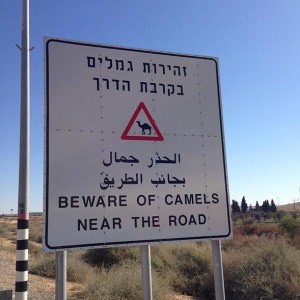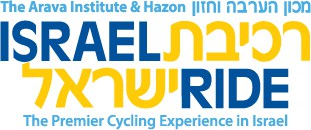Rabbi Lev Herrnson, 2014 Israel rider, explores his experience on the Israel Ride and his connection to the wilderness of Israel’s south.
 When his brothers had gone to pasture their father’s flock at Shechem, Jacob said to Joseph, “Go and see how your brothers are faring…” [On his way] …a man came upon [Joseph] wandering in the fields. The man asked him, “What are you looking for?” [Joseph] answered, “I am looking for my brothers…” The man said, “…I heard them say: Let us go to Dothan.” So Joseph followed his brothers and found them at Dothan. (Genesis 37:12-18)
When his brothers had gone to pasture their father’s flock at Shechem, Jacob said to Joseph, “Go and see how your brothers are faring…” [On his way] …a man came upon [Joseph] wandering in the fields. The man asked him, “What are you looking for?” [Joseph] answered, “I am looking for my brothers…” The man said, “…I heard them say: Let us go to Dothan.” So Joseph followed his brothers and found them at Dothan. (Genesis 37:12-18)
The stranger’s intervention initiates a series of fateful events. As a result of these events, Jacob’s family expands from a tribe into the people Israel and, some 400 years later, the Israelites escape the bonds of Egypt, becoming a nation in the process.
Dinah, like Joseph her younger brother, also sets out into the wilderness; in her case, she goes to see how the other young women are faring. As reported in this week’s portion, while in the wilderness, Dinah encounters Shechem, who violently assaults her. As a result, Dinah and her family are profoundly changed forever.
Happening upon a stranger in the wilderness is a motif that signals dramatic change. The most well known example is of Moses, who encounters the greatest of all strangers, God. And Moses is changed profoundly because of his encounter.
Wilderness encounters are unpredictable. They can precipitate greatness, as in the case of Moses, or assault and violence, as in the case of Dinah, or both, as in the case of Joseph. All of these encounters are noteworthy, beckoning us to study them carefully.
I participated in the 2014 Israel Ride, which took place largely in the wilderness between Jerusalem and Eilat, including the same region where Joseph’s brothers fabricated his death, and Shechem defiled Dinah. While my own experiences don’t rise to the level of significance of the episodes reported in the Torah, I learned some noteworthy lessons during my own wilderness encounter this past November and am profoundly affected by them.
First, I needed to train, and long term plan to do so. And I also needed to learn cycling techniques and strategies to be successful while on a large group ride on steep and sometimes unpredictable, arid terrain. My efforts were rewarded as I cycled nearly 350 miles and climbed over 20,000 feet in elevation over the course of five days. And while this was a great personal accomplishment requiring physical conditioning and endurance, the Israel Ride also offered encounters in the wilderness that challenged my heart and mind.
Cycling can be dangerous, and the Israel Ride was no exception. Consider the members of our group. Most were in their 40s and 50s, with one rider 14 years of age, and some well into their 70’s. Some were experienced cyclists, and others, like me, were new to the sport. Physical conditioning and body type ran the gamut, as did skill level and speed. Some of us had been to Israel many times, while a surprising number of participants had never been to Israel before and made this, a commitment of endurance and fortitude, their first trip. And, of course, we were a newly formed group of 170 people that had never before cycled together. Considering all these variables, anything could go wrong. Still, we set out on our journey from Jerusalem into the wilderness.
It rained on Tuesday night, so the road out of the city was wet on Wednesday morning, the air humid, and the hills blanketed in mist. The descent from Jerusalem was a long drop of over 1,400 feet on a steep and, at times, serpentine route. This was no ordinary bike ride. For reasons of safety, the police closed the road to regular traffic, and the ride organizers sent us down the initial, huge descent, one-by-one.
Having fallen from my bicycle on a wet road at high speed in September, I descended slowly, pumping my brakes: Rear brake, front brake, hold, release. Rear, front, hold, release. I didn’t want to fall a second time. Indeed, we all traveled slowly, carefully, exiting Jerusalem and magnificent, but steep hills. Amazingly, our hands and arms cramped from exhaustion on the way down. At the first rest stop, I dismounted, my arms shaking from fatigue. I wasn’t the only one. Like so many others, I learned that I can descend safely, but that it takes a lot of effort and care to do so.

Lev, riding into Makhtesh Ramon
on the 2014 Israel Ride
For every downhill ride, there’s also an uphill climb. On some days we covered more than 75 miles and nearly 6,000 feet of climbing. Climbing is all about leg strength and, on day two, my right knee was giving me trouble and I was losing power. I realized that I couldn’t continue. The pain, a “souvenir” from my accident in September, caused me to miss out on 15 miles that day. Instead, I climbed onto the bus and iced my knee for an hour. By the time lunch was over, I was able to ride again, and on all the subsequent days as well, without interruption. I swallowed my pride on day two—I wasn’t going to be a hero. Instead, I made a choice that enabled me to ride later that day, and for the rest of the journey. Had I continued riding, I likely would have injured myself further and probably missed out on Days 3-5.
Riding in the desert in 90-degrees in zero humidity, sometimes up hills, and other times down steep descents, also tested our internal resources. Staying hydrated in the desert actually requires real effort when you’re exerting yourself, as does taking the right kind of nutrition at the proper intervals to ensure that you don’t run out of steam. On day three I surprised myself with respect to my conditioning and my skills.
Myles, a rider from Delaware and a new friend, is an accomplished cyclist. I managed to keep up with him most of the days, so we rode together often. On one particularly hot day, while riding in the bottom of a desert valley near Egypt, we saw—far off in the distance, the lead riders for our group. Myles said, “Let’s try and catch them!” He asked, “Do you know how to draft in a crosswind?” Drafting—riding in the invisible pocket of air twelve-eighteen inches behind the rear wheel of the rider in front of you, can save you 30% or more in power. When drafting, everyone takes a turn as the lead rider, which requires a hard effort for 20-40 seconds at a time. After his “pull” is done, the lead rider rotates out and then the next person in the draft pulls into the lead position, giving the lead rider time to recover. “Only in a headwind,” I answered. Myles then described to me the position of my bicycle relative to his own when drafting in a crosswind. We took turns pulling while the other recovered and, sure enough, we caught up to the lead riders in a matter of five minutes or so. In addition to a real sense of accomplishment and an amazing adrenaline rush, I also recognized that I was, at that moment, changed because of someone I met in the wilderness. We worked as a team and realized our goal. Strategy won the day.
My most challenging encounter took place in the desert on day four. Over Shabbat, in Mitzpe Ramon, I encountered a stranger. He told me about his studies. A student of chemistry and hydrology, his expertise may one day lead to better water management among all of the nations in the Middle East. His name is Basam, and he is an Arab from Jordan. He is a student at the Arava Institute, one of the two beneficiary organizations of the Israel Ride. With this tidbit of information, I found myself in a new wilderness. Before me stood an well-educated young man, who had the courage to leave his family and friends behind in Jordan, so that he might study with other Muslims, Christians, and Jews in Israel. He may very well have severed ties with some of his family and friends because of his choice to be in dialogue with Israelis. Dazed by his bravery and amazed by his principles, I found myself asking if I would have the courage to do the same? Could I, for instance, leave my family behind and study with strangers in a foreign land?
Basam’s story is even more astonishing. He went on to explain that his father, a member of the Jordanian air force, fought against Israel in the War of Independence and in subsequent wars. Still, when he told his parents what he wanted to do—to study with Jews in Israel, his mother said, “You must go” and his father offered his blessing.
Basam wasn’t alone. There were others from the West Bank, Egypt and Morocco who came to Israel to study and to engage in dialogue. Listening to Basam and the others, I thought to myself, these kids, like poker players in Vegas, are “all in.” They bravely ventured into what could be a truly inhospitable wilderness with the hope of being changed, and perhaps changing others.
I, for one, am changed. Changed because of the experience of cycling in a very large group. Changed because of the physical challenges the ride presented. Changed also because of the people I met—the group of guys from a synagogue outside of a metropolitan area, because of Myles, my “drafting coach,” because of the grandmother from Brooklyn—who returned to Judaism after a distance of some years and, in particular, changed because of the students from all over who sought out dialogue in the desert wilderness.
In Hebrew the desert or wilderness is called “midbar“, a desolate place with sparse vegetation and even fewer inhabitants. Midbar, the word, shares the same foundation as the verb midaber, “to speak.” Tour guides in Israel are quick to tell you that, if you spend enough time in the midbar, the wilderness will speak to you. The wilderness may speak with a thunderous voice, rattling you to your core, propelling you to greatness. The wilderness may also threaten and menace in the softest of voices, distorting your reality if you allow it. While the wilderness experience is unpredictable, it is best encountered when you’ve prepared yourself for the encounter, because you never know who you will meet there. In my case, I found God in the physical challenge before me, in the faces I saw and the humanity I experienced.
I hope to repeat the experience in 2016.





Comments are closed.